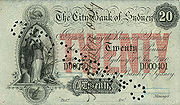
Australian Bank Notes Tax Act 1910
Encyclopedia

Private currency
A private currency is a currency issued by a private organization. It is often contrasted with fiat currency issued by governments or central banks. In many countries, the issue of private paper currencies is severely restricted by law....
in Australia
Australia
Australia , officially the Commonwealth of Australia, is a country in the Southern Hemisphere comprising the mainland of the Australian continent, the island of Tasmania, and numerous smaller islands in the Indian and Pacific Oceans. It is the world's sixth-largest country by total area...
.
It is a federal law that imposes on all bank issued currency a tax of ten per cent. The tax applies on "all bank notes issued or re-issued by any bank in the Commonwealth after the commencement of this Act, and not redeemed."
The effect of the tax was to bring to an end the historical practice of private sector currency creation in Australia.
Prior to the act of 1910, the dominant form of currency in Australia was state issued currency and bearer redeemable promissory note
Promissory note
A promissory note is a negotiable instrument, wherein one party makes an unconditional promise in writing to pay a determinate sum of money to the other , either at a fixed or determinable future time or on demand of the payee, under specific terms.Referred to as a note payable in accounting, or...
s issued by private banks and denominated in pound sterling.
The Act allowed the Federal government Treasurer to issue notes in denominations of 10s., £1, £5, £10, and any multiple of £10. These were to be legal tender and payable in gold coin on demand at the Commonwealth Treasury.
This act perpetuates the effective prohibition of private currencies in Australia.
External links
- http://www.rba.gov.au/CurrencyNotes/history.html
- Australian ban on private coins

